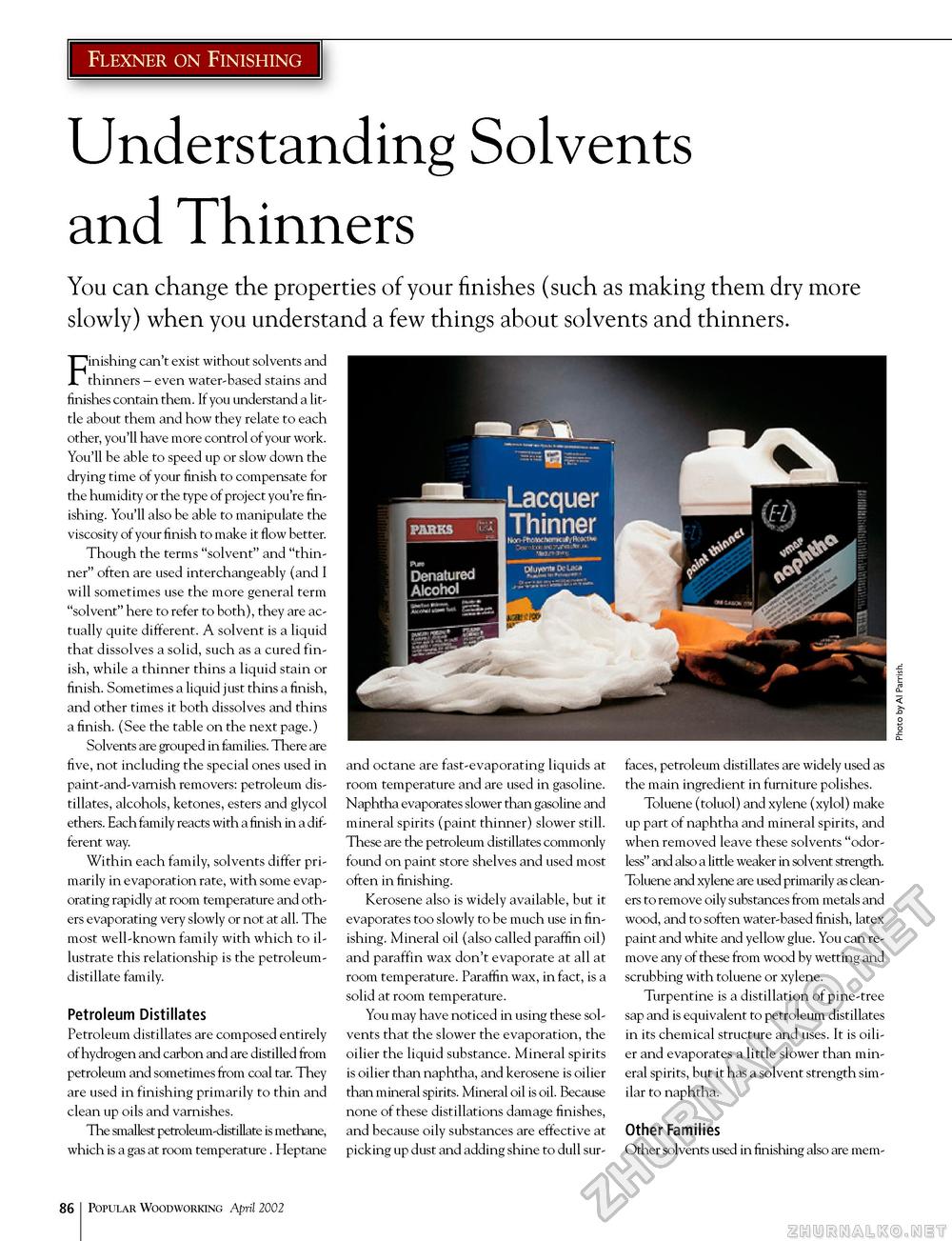Popular Woodworking 2002-04 № 127, страница 84
Flexner on Finishing Understanding Solvents and Thinners You can change the properties of your finishes (such as making them dry more slowly) when you understand a few things about solvents and thinners. Finishing can t exist without solvents and thinners - even water-based stains and finishes contain them. If you understand a little about them and how they relate to each other, you'll have more control of your work. You'll be able to speed up or slow down the drying time of your finish to compensate for the humidity or the type of project you're finishing. You'll also be able to manipulate the viscosity of your finish to make it flow better. Though the terms "solvent" and "thinner" often are used interchangeably (and I will sometimes use the more general term "solvent" here to refer to both), they are actually quite different. A solvent is a liquid that dissolves a solid, such as a cured finish, while a thinner thins a liquid stain or finish. Sometimes a liquid just thins a finish, and other times it both dissolves and thins a finish. (See the table on the next page.) Solvents are grouped in families. There are five, not including the special ones used in paint-and-varnish removers: petroleum distillates, alcohols, ketones, esters and glycol ethers. Each family reacts with a finish in a different way. Within each family, solvents differ primarily in evaporation rate, with some evaporating rapidly at room temperature and others evaporating very slowly or not at all. The most well-known family with which to illustrate this relationship is the petroleum-distillate family. Petroleum Distillates Petroleum distillates are composed entirely of hydrogen and carbon and are distilled from petroleum and sometimes from coal tar. They are used in finishing primarily to thin and clean up oils and varnishes. The smallest petroleum-distillate is methane, which is a gas at room temperature . Heptane and octane are fast-evaporating liquids at room temperature and are used in gasoline. Naphtha evaporates slower than gasoline and mineral spirits (paint thinner) slower still. These are the petroleum distillates commonly found on paint store shelves and used most often in finishing. Kerosene also is widely available, but it evaporates too slowly to be much use in finishing. Mineral oil (also called paraffin oil) and paraffin wax don't evaporate at all at room temperature. Paraffin wax, in fact, is a solid at room temperature. You may have noticed in using these solvents that the slower the evaporation, the oilier the liquid substance. Mineral spirits is oilier than naphtha, and kerosene is oilier than mineral spirits. Mineral oil is oil. Because none of these distillations damage finishes, and because oily substances are effective at picking up dust and adding shine to dull sur < .o O 0 01 faces, petroleum distillates are widely used as the main ingredient in furniture polishes. Toluene (toluol) and xylene (xylol) make up part of naphtha and mineral spirits, and when removed leave these solvents "odorless" and also a little weaker in solvent strength. Toluene and xylene are used primarily as cleaners to remove oily substances from metals and wood, and to soften water-based finish, latex paint and white and yellow glue. You can remove any of these from wood by wetting and scrubbing with toluene or xylene. Turpentine is a distillation of pine-tree sap and is equivalent to petroleum distillates in its chemical structure and uses. It is oilier and evaporates a little slower than mineral spirits, but it has a solvent strength similar to naphtha. Other Families Other solvents used in finishing also are mem 86 Popular Woodworking April 2002 |







